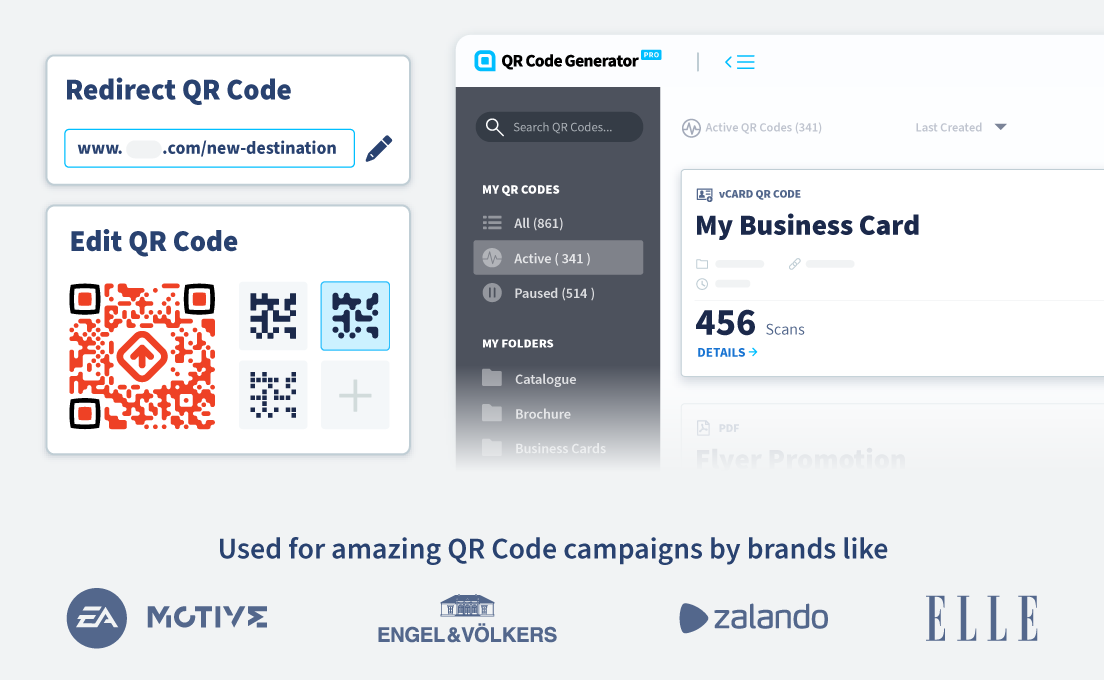- Best Practices ●
- COVID-19 ●
- Industry Trends ●
- Partners ●
- Product ●
QR Code Analytics: The Definitive Guide to Tracking and Analysis
What if every QR Code scan could uncover more than just its destination?
Whether browsing a cafe’s digital menu or checking in for an event, Quick Response (QR) Codes have become a part of everyday life—making it easy to access information with a single scan. But there’s more to each interaction than meets the eye.
Behind every scan is a trail of valuable data that can reveal user behaviors, campaign performance, and engagement patterns. Each scan tells a unique story: when, where, and how someone interacted with your content. These insights empower you to refine your marketing strategy, measure impact, and create more effective campaigns.
In this guide, we’ll explain how QR Codes work, why they matter, and how to use them to make smarter, more impactful business decisions.
*Note: All brands and examples discussed below were found during our online research for this article.
QR Code tracking: The gateway to QR Code analytics
Wondering how your audience responds to your QR Codes? QR Code tracking reveals valuable data, like scan frequency and user preferences, so you can measure campaign effectiveness with ease.
However, not all QR Codes offer tracking capabilities. There are two types: Static QR Codes and Dynamic QR Codes. Static Codes store all the data directly in the code itself, so they can’t be tracked or updated after printing. On the other hand, Dynamic QR Codes link to a short, trackable URL that redirects to your desired content. This makes them trackable and editable, even after printing.
By using trackable QR Codes, you can unlock insights like the number of scans a code receives, scan locations, device operating systems, and when scans occurred. QR Code analytics transforms this data into actionable insights, so you can refine your campaigns and better understand your audience.
Ready to gain insights into your audience interactions? Learn how to track QR Code scans today!
What are QR Code analytics?
QR Code analytics refers to the real-time data, statistics, and insights collected from QR Code scans. This data provides a detailed view of how your codes are being used.
For instance, tracking might show you that your QR Code was scanned 20,000 times last month, giving you a clearer picture of your campaign’s reach. If your goal was 10,000 scans, then you’ve exceeded expectations.
Conversely, if you expected 50,000 scans, you might reassess your strategy—integrating QR Codes into multiple channels, optimizing placement, or even adjusting the color scheme or CTA. Together, QR Code tracking and analytics can help you optimize your strategy for better results.
Content creators, social media teams, marketers, and entrepreneurs rely on QR Code analytics to:
- Understand how people are accessing their QR Codes.
- Gain valuable insights into their content performance.
- Adjust campaigns based on metrics and key performance indicators (KPIs).
Many QR Code generators offer built-in data analytics, providing a dashboard where you can track performance without needing third-party tools like Google Analytics.
QR Code analytics differ from website analytics, which often track metrics like page views, click-through rate (CTR), and bounce rate. With QR Codes, key metrics include location data, scan frequency, and timestamps—insights tailored to physical-to-digital interactions.
The advantages of QR Code analytics
QR Code usage is growing steadily. As their popularity grows, businesses are leveraging QR Codes to share information and collect data that can drive better marketing decisions. Here’s how QR Code analytics can make a difference:
Improved decision-making
QR Code analytics dashboards give you the clarity to make smarter, data-driven marketing moves—so you can focus on what works best. Instead of guessing a campaign’s effectiveness, you can review detailed metrics to adjust your strategy.
Let’s say you’re creating a QR Code for an upcoming product launch. With QR Code analytics, you can use the data to:
- Measure how many times customers engage with your linked content to gauge interest in the new product.
- Review data alongside other analytics tools (like Google Analytics) to determine if scans are leading to conversions (such as inquiries or presale sign-ups).
- Distinguish where users are at the country and city level to determine future location-based campaign targeting.
Depending on your campaign’s performance, you can adjust your strategy, update the linked content, or launch a new QR Code campaign. QR Code testing is essential before promoting your codes, as it helps identify any issues that could impact their functionality.
Measuring marketing campaign effectiveness
Whether you’re aiming to improve brand accessibility or boost conversions, QR Code analytics can reveal whether you’re hitting your targets.
Many auto dealers place QR Codes on vehicles to share manufacturing specs and pricing information with potential buyers. By tracking scan data, they can see how frequently the codes are scanned, providing insight into campaign reach and interest.
This data empowers the dealers to refine their marketing strategies—redirecting efforts where they make the biggest impact.
Enhanced user understanding
Businesses can better understand audience habits and preferences by analyzing metrics like scan location, device type, and scan time. These insights can help you create detailed buyer personas—making future campaigns more targeted and effective.
If you include QR Codes on promotional products, analytics can reveal which regions scanned the code most frequently. This data allows you to create targeted campaigns and deliver relevant marketing messages to different demographics.
Track conversion rates
QR Code analytics show how often your codes are scanned, but to track what happens afterward—like purchases, newsletter sign-ups, or webpage visits—you’ll need to pair them with a supporting tool, such as Google Analytics.
By monitoring these conversion rates, you can better assess whether your marketing campaigns drive meaningful results and make informed adjustments as needed.
What types of data can QR Code analytics yield?
QR Code tracking provides access to a wide range of metrics you can use to improve your QR Code marketing campaigns. Here are the key data points you can track with QR Code Generator PRO:
Total scans
This metric represents the total number of scans a QR Code receives, giving you a clear overview of the code’s reach and overall effectiveness.
Much like website traffic, total QR Code scans serve as a basic performance benchmark. Their importance depends on your marketing goals. Total scans might be a top priority if you aim to boost brand awareness. However, if conversions are your focus, this metric alone may not offer the full picture.
Unique scans
Unique scans reflect the number of individual devices that have scanned your QR Code. For instance, if seven people scanned the code but one person scanned it twice, the data would show seven unique scans and eight total scans.
This metric gives you a good idea of your audience size and reach.
Location data
You can track where your QR Codes are scanned, helping you identify geographic areas where your campaigns are most effective.
Location data is particularly useful for local marketing efforts. A doctor’s office could use QR Codes in promotional materials and track where scans are coming from to refine its future campaigns to target specific locations and demographics.
Device type & operating system
Knowing what devices your audience uses can help you create more tailored campaigns. QR Code analytics can show you whether users are scanning with Android, iOS, Windows, Linux OS, or Chrome OS devices.
This insight lets you optimize your content for different devices and platforms to ensure a consistent customer experience.
Other helpful metrics
Some QR Code generators also give insights into other scan data, including:
- Scan timestamps: Reveals peak engagement times, which can help you adjust campaign timing for better results. If your audience tends to scan codes most often in the afternoon, you might schedule future campaigns around that time to maximize engagement.
- Browser information: Knowing whether users prefer Safari, Chrome, or Firefox can help you optimize linked content for the most popular browsers.
- Referral source: Provides insights into where scans originated, showing you which channels or materials are driving engagement. This can be especially useful for cross-channel campaigns and other digital marketing efforts, as it helps you understand whether scans are coming from printed materials, emails, social media posts, or other touchpoints.
- Live notifications: Helps you monitor activity as it happens and can be useful for tracking campaign performance during live events or product launches.
Using QR Code analytics vs. Google Analytics
A dedicated QR Code analytics platform offers a streamlined solution for managing all your important data in one place. However, you don’t have to rely solely on data from your QR Code generator. You can also use Google Analytics—it’s great for tracking QR Code performance, especially when you’re using UTMs to monitor referral traffic.
Using both QR Code analytics and Google Analytics can help create more comprehensive performance reports. Google Analytics can help you know what users are doing once they are on your page, while QR Code analytics provide real-time insights into scans, customer locations, and popular devices.
However, even with a robust third-party solution like Google Analytics, it’s important to include QR Code analytics when monitoring scan data for several reasons:
Purpose-built for QR Codes
QR Code generators are specifically designed for creating and managing QR Codes, with specialized features and a user-friendly interface built for this purpose. They also provide a dedicated dashboard where you can easily access analytics to measure your campaign’s performance.
Integrated analytics
With a QR Code generator, the analytics are integrated directly into the QR Code creation process, eliminating the need for separate tracking parameters or URLs. This built-in functionality simplifies the process of gathering and reviewing campaign data.
QR Code-specific metrics
Unlike Google Analytics, QR Code generators provide metrics tailored specifically for QR Code campaigns, such as unique scans, total scans, scan locations, device types, and timestamps. These insights provide a detailed view of how your QR Codes are performing without requiring a complex setup.
QR Code Generator PRO: Your all-in-one solution for smarter insights
QR Code analytics empower marketers to make informed, data-driven decisions that can transform campaign outcomes. By tracking metrics like total scans, unique scans, and scans by location, you better understand how audiences engage with your QR Codes—helping you refine your strategy, measure impact, and focus on what drives success.
With QR Code Generator PRO, you can create, manage, and track your QR Codes effortlessly—all from a single platform. Our intuitive dashboard gives you real-time insights without complicated setups, so you can confidently make smarter marketing decisions. Plus, you’ll enjoy unlimited scans and customizable QR Codes tailored to your brand’s unique style.
Ready to unlock deeper insights into your QR Code marketing campaigns? Sign up for QR Code Generator PRO today!






 Add custom colors, logos and frames.
Add custom colors, logos and frames.
